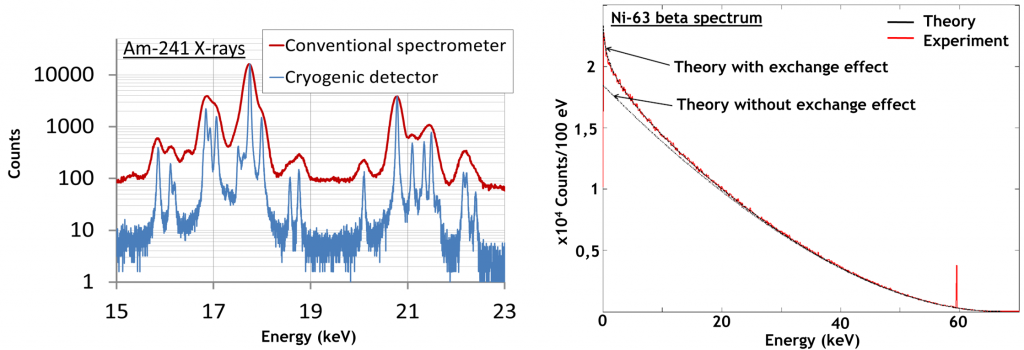Cryogenic detectors

Metallic magnetic calorimeters for ionizing radiation metrology
 The LNHB develops and uses cryogenic detectors for energy spectrometry of particles and radiation (α, β–, e–, X or γ, …) emitted as a result of radioactive decays. A cryogenic detector is a thermal detector that measures the energy of each absorbed particle as a temperature rise through an extremely sensitive and fast thermometer. The thermometers used are magnetic thermometers, they convert a temperature variation into a magnetization variation. A low-noise SQUID (“Superconducting Quantum Interference Device”) electronics lowers the signal voltage and amplifies it.
The LNHB develops and uses cryogenic detectors for energy spectrometry of particles and radiation (α, β–, e–, X or γ, …) emitted as a result of radioactive decays. A cryogenic detector is a thermal detector that measures the energy of each absorbed particle as a temperature rise through an extremely sensitive and fast thermometer. The thermometers used are magnetic thermometers, they convert a temperature variation into a magnetization variation. A low-noise SQUID (“Superconducting Quantum Interference Device”) electronics lowers the signal voltage and amplifies it.
High sensitivity can only be achieved by operating the detector at a very low temperature (approximately 20 mK above absolute zero, i.e. -273.13 °C) in order to reduce thermal noise sources and increase the amplitude of the measured signal. These extreme temperatures are achieved by means of a He-3 / He-4 dilution refrigerator. Cryogenic detectors then offer performance that is inaccessible to conventional semiconductor or scintillator detectors in terms of energy resolution and detection threshold.
 Applied to low-energy X- and γ photon spectrometry below 100 keV, the SMX3 detector offers a half-maximum resolution of 30 eV at 60 keV, an order of magnitude better than an HPGe semiconductor detector. The complex XL and γ spectra emitted by the Pb-210 and Am-241 have been measured with great precision, revealing the presence of so-called “satellite” rays hitherto imperceptible by conventional detectors.
Applied to low-energy X- and γ photon spectrometry below 100 keV, the SMX3 detector offers a half-maximum resolution of 30 eV at 60 keV, an order of magnitude better than an HPGe semiconductor detector. The complex XL and γ spectra emitted by the Pb-210 and Am-241 have been measured with great precision, revealing the presence of so-called “satellite” rays hitherto imperceptible by conventional detectors.
In addition, the cryogenic detectors of LNHB are used for β– spectrometry. In this case, the measured radionuclide is enclosed in the detector to absorb all β– particles and have a detection efficiency of 100%. The β spectra of Ni-63 and Pu-241 were measured with a very low detection threshold demonstrating the importance of the low-energy exchange effect for these radionuclides. These β spectra measured with fidelity are essential for the improvement of theoretical calculation codes.

Our job: metrology
dosimetry
Implemented methods for the establishment of national references must be adapted to the radiation type and its intensity. They are based on measurement technics such as calorimetry, ionometry and chemical dosimetry.
Radioactivity
The variety of the emitted radiation and physical forms of the sources oblige to adapt the measurement process in order to establish national references: methods with defined geometries, or 4 π countings geometries, coincidence countings, etc.
